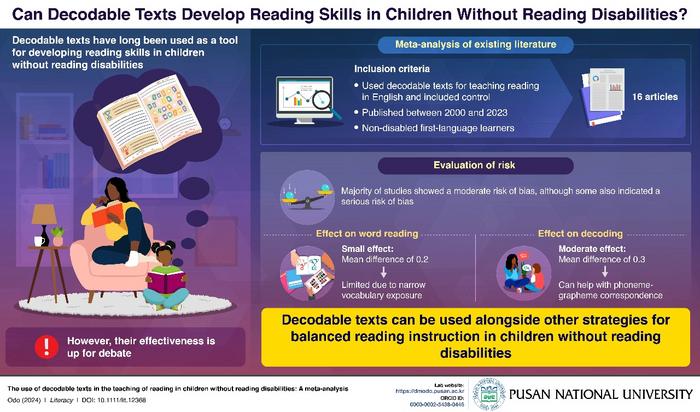Reading is a key skill for success in school as well as for existence in today’s society, casting its influence on education, employment, and social activities. However, for young children, taking the first step towards reading can feel like an uphill task. This is because a child might find it easy to recognize individual letters but combining them into sentences can be overwhelming in the beginning. Moreover, the process of reading requires the brain to juggle many tasks at once, such as recognizing letters, connecting them to sounds, and understanding the meaning of those sounds.

Credit: Professor Dennis Murphy Odo from Pusan National University, South Korea
Reading is a key skill for success in school as well as for existence in today’s society, casting its influence on education, employment, and social activities. However, for young children, taking the first step towards reading can feel like an uphill task. This is because a child might find it easy to recognize individual letters but combining them into sentences can be overwhelming in the beginning. Moreover, the process of reading requires the brain to juggle many tasks at once, such as recognizing letters, connecting them to sounds, and understanding the meaning of those sounds.
The English language poses unique additional challenges, as spellings are not always straightforward. The same combination of letters can produce different sounds (like “ough” in “though” and “bough”), and some sounds have multiple spellings (“see” and “sea”). This is where decodable texts come in. Decodable texts are designed to help children improve their reading skills by focusing on transparent letter-sound relationships they have been taught. These texts assist beginning readers in decoding words by breaking them into familiar sounds and blending them together.
However, critics believe that decodable texts do not offer enough exposure to authentic reading material, potentially leading to a narrow focus on decoding rather than comprehension. To explore this issue, Professor Dennis Murphy Odo from Pusan National University conducted a meta-analysis to gather evidence on their effectiveness in facilitating reading. In his new study published in the journal Literacy on 3 May 2024, Prof. Odo analyzed how decodable texts impact early reading skills.
The meta-analysis revealed that the average standardized mean difference (measured as Hedge’s g: a measure of effect size) for word reading was small (g=0.20), while it was moderate for pseudoword decoding (g=0.30). This highlights how decodable texts can facilitate word reading and decoding to some degree, but they need to be used in combination with other reading instructional materials.
“The small to moderate effect sized indicates that decodable texts can have a meaningful impact on reading skills, especially in decoding difficult words, which is crucial for phonemic awareness and later reading success,” says Professor Odo, while discussing the results.
Decodable texts can be a valuable asset in teachers’ toolkit. Elaborating further, Prof. Odo adds, “Decodable texts provide a structured and predictable way to introduce and practice reading skills systematically.” They can also make learning to read more engaging for young students, fostering their confidence as they develop their reading abilities.
Schools can incorporate decodable texts into their reading programs, providing young learners with access to effective instruction and a variety of resources to support their reading development. “However, research also indicates that decodable texts alone may not be sufficient to ensure overall reading success. Other factors, such as a child’s background and the variety of teaching methods used, can also significantly impact reading development,” Prof Odo adds.
This study thus highlights the importance of a balanced approach to reading instruction. It also underscores the need for further studies to explore how decodable texts can be most effectively integrated into reading instruction.
In summary, these findings have important implications for reading programs and educational policies. “Policymakers should take a broad approach to reading instruction, using different strategies and focusing on the overall development of the child,” suggests Prof. Odo. “It’s also crucial to invest in teacher training to ensure they can effectively use decodable texts and other helpful materials.“
***
Reference:
About the institute
Pusan National University, located in Busan, South Korea, was founded in 1946 and is now the No. 1 national university of South Korea in research and educational competency. The multi-campus university also has other smaller campuses in Yangsan, Miryang, and Ami. The university prides itself on the principles of truth, freedom, and service, and has approximately 30,000 students, 1200 professors, and 750 faculty members. The university is composed of 14 colleges (schools) and one independent division, with 103 departments in all.
About the author
Prof. Murphy Odo received his Ph.D. in Language and Literacy Education from UBC. He previously served as an in-service public school TESOL methods teacher trainer in Canada and for the Korean Ministry of Education and as an Assistant Professor of ESOL/ Reading education at Georgia State University, where he taught courses in first and second language reading. He is currently a Professor in the department of English Education at Pusan National University, where he teaches courses in second language acquisition and literacy instructional methods. His main research interests include learner autonomy, technology, second language literacy instruction, and teacher development.
Website:
ORCID id: 0000-0002-5438-0446
Journal
Literacy
Method of Research
Meta-analysis
Subject of Research
Not applicable
Article Title
The use of decodable texts in the teaching of reading in children without reading disabilities: a meta-analysis
Article Publication Date
3-May-2024
COI Statement
The authors declare that they have no competing interests.



